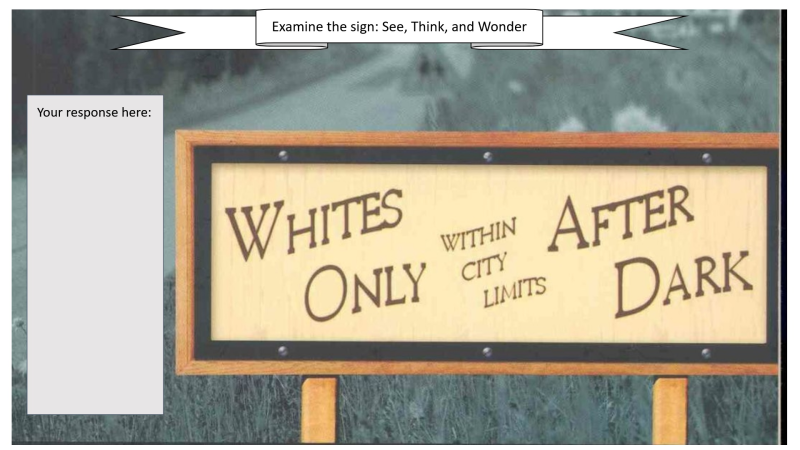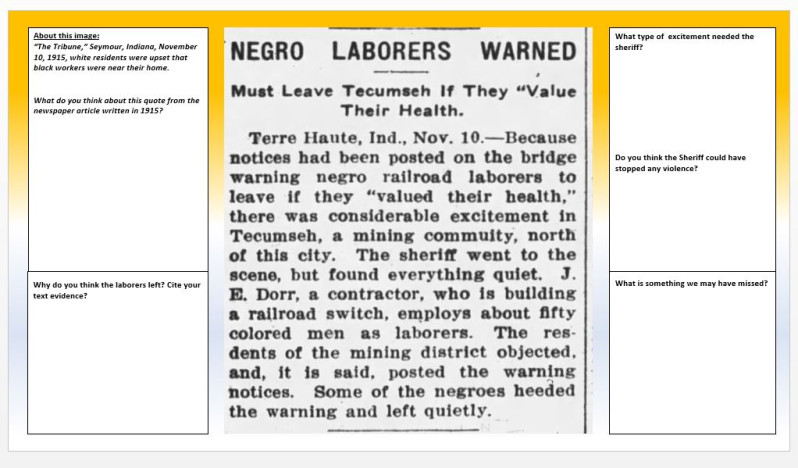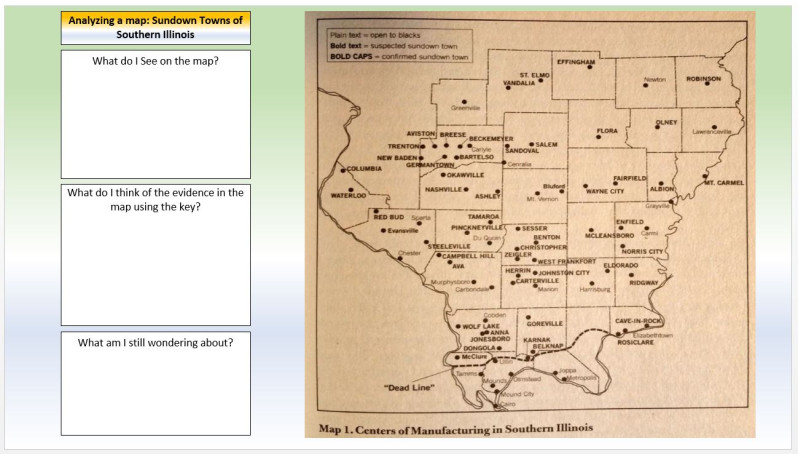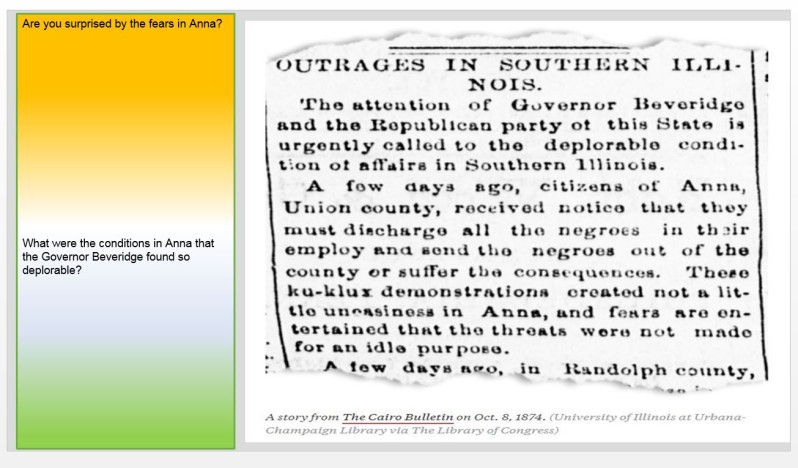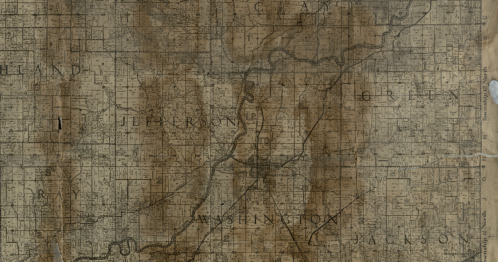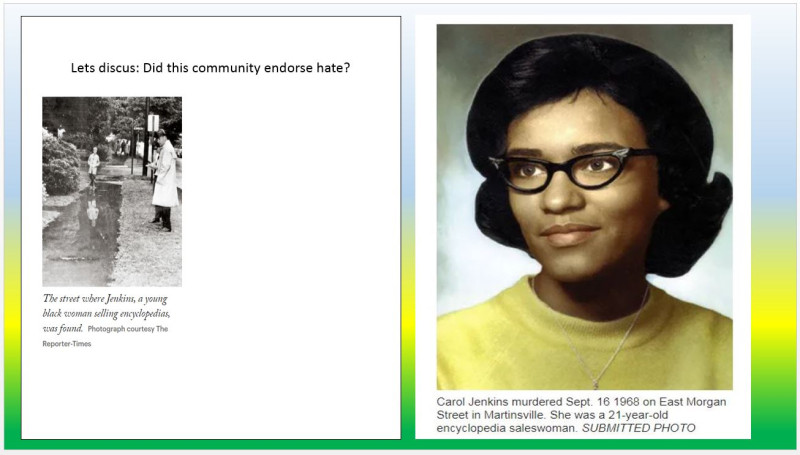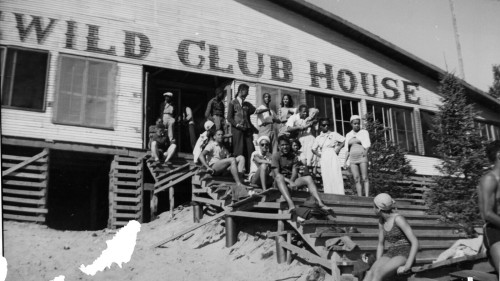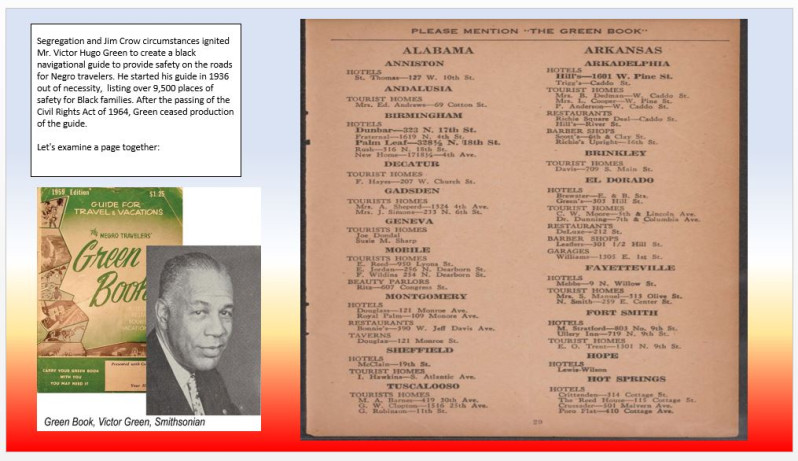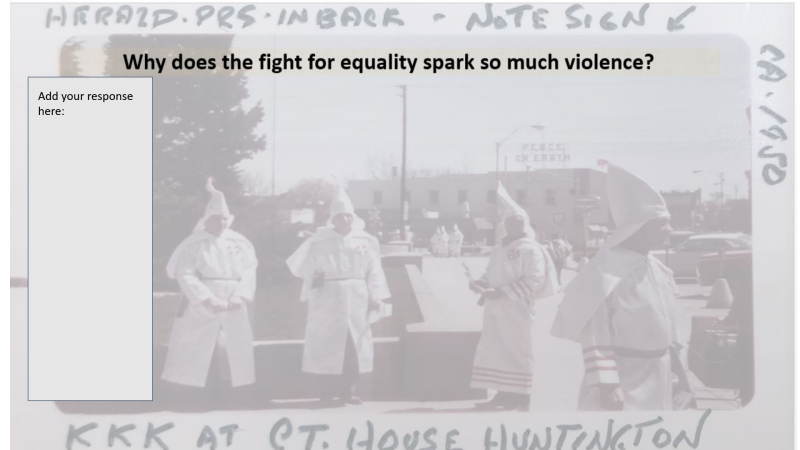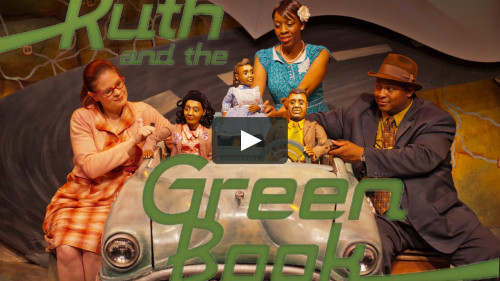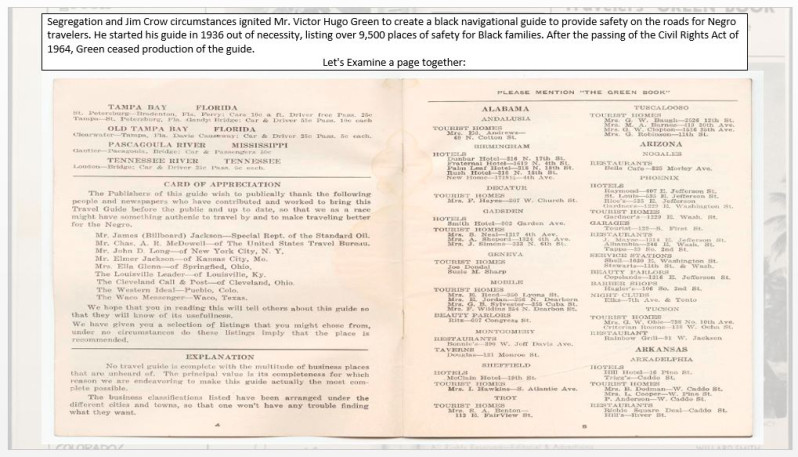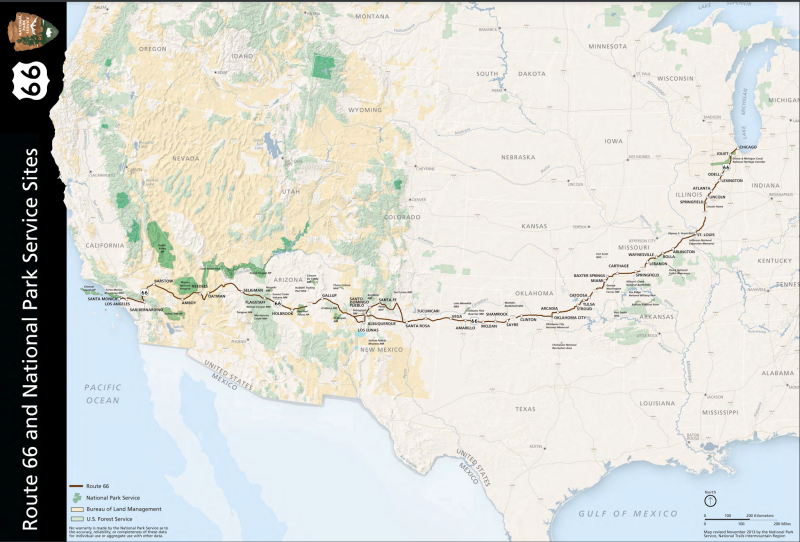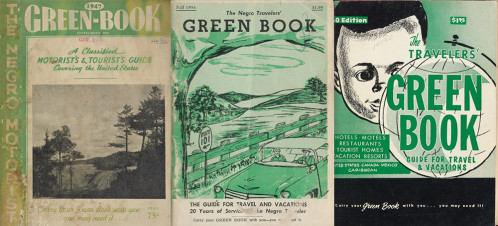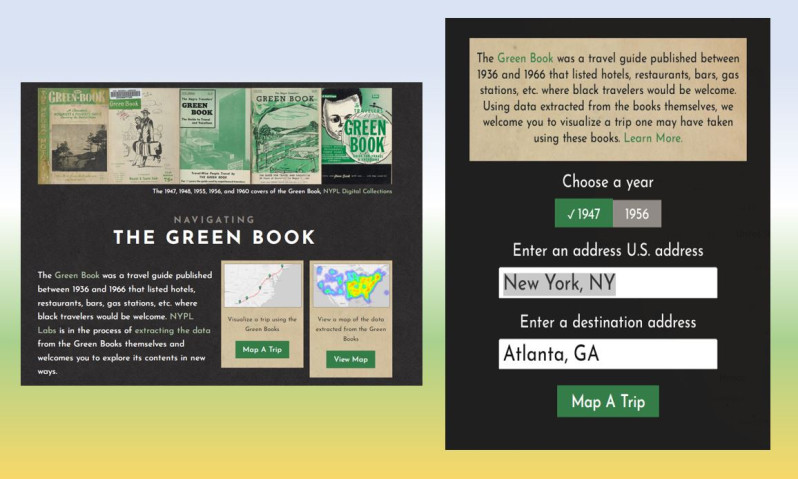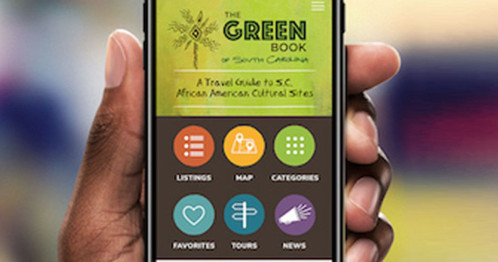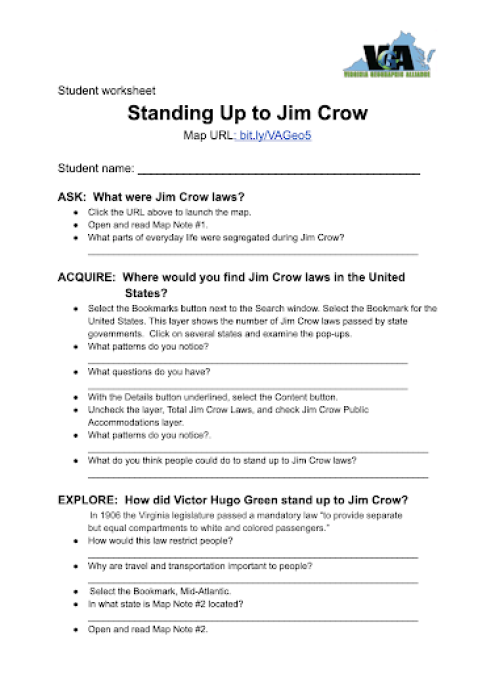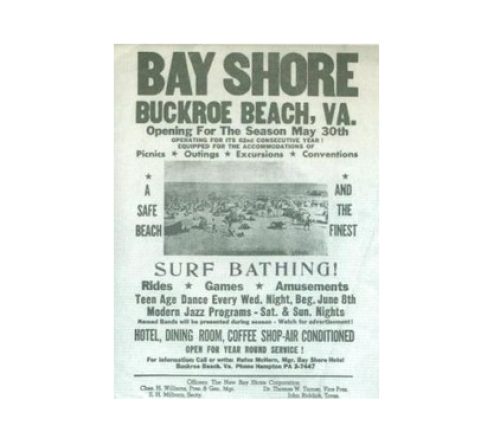This work by New American History is licensed under a Attribution-NonCommercial-ShareAlike 4.0 (CC BY-NC-SA 4.0) International License. Permissions beyond the scope of this license may be available at newamericanhistory.org.
The Negro Motorist Green Book
View Student Version
Standards
C3 Framework:D2.Civ5.9-12. Evaluate citizens’ and institutions’ effectiveness in addressing social and political problems at the local, state, tribal, national, and/or international level.D2.Civ.12.9-12. Analyze how people use and challenge local, state, national, and international laws to address a variety of public issues. D2.Civ.13.9-12. Evaluate public policies in terms of intended and unintended outcomes and related consequences.
National Council for Social Studies:Theme: Power, Authority, and GovernanceTheme: Civic Ideals and Practice
National Geography Standards: Standard 4. The physical and human characteristics of places.Standard 6. How culture and experience influence people’s perceptions of places and regions.Standard 12. The processes, patterns, and functions of human settlement Standard 13. How the forces of cooperation and conflict among people influence the division and control of Earth’s surface
Teacher Tip: Think about what students should be able to KNOW, UNDERSTAND, and DO at the conclusion of this learning experience. A brief exit pass or other formative assessment may be used to assess student understandings. Setting specific learning targets for the appropriate grade level and content area will increase student success.
Suggested Grade Levels: Middle School, (6-8) High School (9-12)
Suggested Timeframe: 3 class sessions, 90 minute block class periods
Suggested Materials: Internet access via laptop, tablet, or mobile device; projector and screen for viewing video segments as a whole group if providing face to face instruction.
Key Vocabulary
Amendment - an official change to a document, law, or policy
Discrimination - the unfair treatment of people based on their race, gender, age, etc.
Endorsement - Support for a cause, candidate, or idea. Often used in marketing, politics, or charity work.
Green Book- an African American travel guide book created by Victor Hugo in 1932 during segregation to navigate drivers of color away from dangerous places in the US. It provided listings of hotels, restaurants, and gas stations that served Black people.
Jim Crow laws - state and local laws that enforced segregation between races
Ku Klux Klan (KKK) - a white supremacist group founded in 1865 to intimidate African Americans and other minority groups from asserting themselves in any way, including politically
Lynching - the illegal killing of people by gangs of violent vigilantes.
Oasis- a fertile spot in a desert, where water is found; a physical location where you can escape the pressures of life, or a mental image of a ” happy place”
Overground Railroad - series of businesses or services outlined in the Green Book to keep Black travelers safe. This is the same type of network of safe spaces set up by abolitionists used by the formerly enslaved people escaping to freedom in the 17th and 18th centuries.
Racial terror - the threat or act of violence based on race used to intimidate and cause fear in its victims
Racism - when a group of people is treated unfairly because of their race/skin color
Resort - a place where people vacation or visit for leisure
Segregation - the race or religion-based separation of people in public spaces including schools, public transportation, restroom facilities, and neighborhoods
Sundown Town - a town that is or was purposely all-white. The term, widely used in the United States, came from signs that were posted stating people of color had to leave the town by sundown. Black people could not visit after sunset or spend the night in the town (even as a paying hotel customer). Such towns are also sometimes called “sunset towns” or “gray towns.”
Toponym - a place name, often associated with a physical feature on the landscape
White Supremacist: A person who practices a form of racism centered upon the belief that white people are superior to people of other racial backgrounds and that whites should politically, economically, and socially dominate non-whites, often associated with violence perpetrated by the KKK and other extremist groups
Read for Understanding
Teacher Tips:
This Learning Resource includes language in the body of the text to help adapt to a variety of educational settings, including remote learning environments, face-to-face instruction, and blended learning.
If you are teaching remotely, consider using videoconferencing to provide opportunities for students to work in partners or small groups. Digital tools such as Google Docs or Google Slides may also be used for collaboration. Rewordify helps make a complex text more accessible for those reading at a lower Lexile level while still providing a greater depth of knowledge.
These learning resources include content about suppressive laws known as Jim Crow laws, acts of racial terror including lynching, and other discriminatory acts or customs used daily in the post-Reconstruction era to remove the rights and freedoms of African Americans and other minority groups in each locale, or by state legislatures. They used these warnings backed with violence to control minorities in America.
African Americans and other minority groups have been subject to implicit biases that have violated their constitutional rights while traveling on American roads. Black people have been stopped and arrested at a higher rate than any other racial group. This link will help further your background knowledge about the historical roots of “Driving While Black in America.” (Note - in some historical contexts, the term “Traveling While Black” was also used interchangeably.)
Please read through each activity and the supporting documents in their entirety to familiarize yourself with the background knowledge before teaching. These learning resources should be taught from a perspective of resilience. Emphasis should be placed on the Green Book’s author and the freedom of movement it afforded people of color despite the dangers they faced while traveling in segregated America. To assist with background knowledge on Sundown Towns, use this resource. In the lesson, the Engage activity contains racially offensive language in a historic image from a sign posted near the city limits of a Sundown town. Teachers should use discretion in using this image, knowing their students, and establishing a community of trust before attempting this lesson in class. For additional guidance, consider these resources from Race Forward and National Geographic.
If students are working remotely, you may provide opportunities for them to collaborate with classmates using video conferencing, access to an online chat feature, or breakout rooms. The Google Slides format used in this learning experience can be modified by moving around the slides, deleting slides, and adding images to the lesson. Click this Google Slides link to open and make a copy of t
The Learning Resources provided feature Bunk Collections, curated groups of Bunk excerpts that share a common topic or theme. In addition, this Learning Resource uses “Thinking Routines” from Project Zero, a research center at the Harvard Graduate School of Education that has developed learning strategies that encourage students to add complexity to their thought process. For an overview of Project Zero’s methodology, you may want to read its Exploring Complexity Bundle. Specifically for this lesson, students will use these thinking routines: See, Think, Wonder. Sketchnotes, or Visual Notetaking, is another strategy used for combining images and text instead of traditional note-taking strategies. A Geoinquiry from the Virginia Geographic Alliance is used in the final Extend activity, allowing students to explore using geospatial tools in an inquiry-based guided learning experience. This Student Handout is provided and you may wish to make your copy to share with students.
Our Learning Resources follow a variation of the 5Es instructional model, and each section may be taught as a separate learning experience, or as part of a sequence of learning experiences. We provide each of our Learning Resources in multiple formats, including web-based and as an editable Google Doc for educators to teach and adapt selected learning experiences as they best suit the needs of your students and local curriculum. You may also wish to embed or remix them into a playlist for students working remotely or independently.
For Students:
African Americans and other minority groups have been subject to treatment that violates their constitutional rights while traveling on American roads. In the Jim Crow era people of color who traveled in the U.S. developed communication methods for safe travel. One of the key publications was called the “Green Book”. In the past it was considered dangerous for some people to be in certain places, particularly after dark and so a guide book was written for travelers to help them stay safe. This lesson looks back at the coping strategies for people of color when traveling in a racist climate. In this learning resource, you will use Google Slides provided by your teacher. You will use a copy of this slide deck to learn more about the Green Book.
Engage:
How did the publication of The Green Book provide safe travels for people of color in the Jim Crow era?
Between 1890 and 1968, thousands of towns across the United States drove out their Black populations or took steps to keep Black residents from moving there. It was very common in some states to have signs warning people of color to leave or face consequences. Many posted signs that read, “N-word, “Don’t Let the Sun Go down on You.” Explain what you think the sign might mean, using slide two provided by your teacher.
- Why would citizens create a sign warning others to stay away?
The Negro Motorist Green Book was created by a postal service employee and travel writer from Harlem named Victor Hugo Green. While his main goal was to provide safe travels for people of color in his home state of New York, The Green Book, sometimes called the Overground Railroad, ultimately included information about safe spaces in cities and states across the country.
On Slide 3, think about these questions as you examine this image:
- Does the sign look inviting to Black people (referred to as “negroes”?
- Would you travel to areas like this?
- Does this sign imply violence for those who do not obey?
The wrong stop at a restroom, diner, or hotel could lead to embarrassment, discrimination, or violence. The Green Book was an innovative publication created to help those Driving While Black arrive safely in a segregated world of uncertainty. An empty tank of gasoline on a highway could lead to an encounter with the Ku Klux Klan. Making a stop in a “Sundown Town,” or a location where African Americans were not permitted after dark, could lead to your death. In the United States, the northern states had more Sundown Towns than the South; Illinois having hundreds and Mississippi only 13.
Turn and talk to an elbow partner, or if working remotely, your teacher may allow you to use a collaborative document such as a Google Doc or have a discussion using video conferencing.
- What rights does the U.S. Constitution guarantee to citizens?
- Do these signs reflect a system that protects equal rights to Life, Liberty, and the pursuit of Happiness?
- What legal rights does the African American community have in these towns?
Next, review this article on Slide 4. Read the article and think about the following questions:
- Why do you think the towns’ people were upset?
- Should the Black (Negro) laborers have been afraid?
Add some additional thoughts to slide four, answering the questions in each square on your copy of the Google slides.
Review a Sundown Town map of Southern Illinois using Slide 5. Continue to use the text boxes to answer each question.
What does the number of Sundown Towns on the map suggest about northern states' willingness to integrate minority citizens?
Your teacher may ask you to submit your answers on an exit ticket.
Explore:
How did white supremacists use advertisements and threats of racial violence to enforce control in Sundown Towns?
Revisit the Sundown Town map you previously viewed on Slide 5. Next, review this Sundown Town slide image from Slide 6. Both are documents not of the American South, but rather the Midwest. Much of the discrimination and violence against Black people took place in Northern, Midwestern, and Western towns such as Pierce City, Missouri, and Anna, Illinois. Take time to view the links to additional information for both of these cities, including the subject of the toponym Anna and the origin of this name. Respond to the questions on Slide 6 in the boxes provided.
Explore the different types of Jim Crow laws in the United States, including those in northern states. Jim Crow laws were state and local mandates put in place to restrict the freedom of minority Americans and maintain inequality. These laws, enacted after the Civil War, legalized racial segregation and made violating them a criminal offense.
- How dangerous do you think it was for Black people to move about in the United States during the Jim Crow era?
- How does this compare to what you know about the safety of Black people moving about in the United States today?
Listen to the story of a victim named Carol Jenkins. In 1968, she was killed in the Sundown Town of Martinsville, Indiana while selling encyclopedias door-to-door. The accused murderer, Kenneth C. Richmond, was arrested on May 8, 2002. He had ties to hate groups, including the Ku Klux Klan.
Read this Bunk excerpt to learn more about the Carol Jenkins slaying, and the experiences of other Black people traveling through a Sundown Town. Compare their experiences to others you read about in this lesson. Add your thoughts to Slide 7 using the text box.
Take a few minutes to explore the Bunk Connections to the article.
- What new information does this excerpt and the others you explored present about topics you have previously discussed, including Sundown Towns, the Green Book, and racial terror?
- What questions do you still have?
- What resources could you explore to find more answers to these questions?
Victor Green created a travel guide for Black motorists in New York City in 1936. The book later expanded into other cities across the United States and beyond. At its height of popularity, over 9,500 entries were logged in The Green Book in every state and some foreign countries. This book became an important milestone in Black history, allowing people of color to have a better chance of arriving safely to their destinations. Today, less than a third of those places listed are still in business. The Green Book travel guide helped improve the quality of life for Black American travelers.
One historical example that predated the Green Book was the Idlewild Resort in Michigan, also known as “Black Eden.” Under the cloud of the violent segregation in the pre-Jim Crow era, Black families found leisure, and recreation as a form of quiet radical resistance. The resort attracted Black professionals, such as cardiologist Dr. Daniel Hale Williams, W.E.B. DuBois, Madam C.J. Walker, and Louis Armstrong, just to name a few. The Green Book later made travel to these Black oases possible and advertised their existence. Read and listen here to learn more about Idlewild.
Think about your own travel experiences, and compare them with those of the Black families traveling by car during segregation. Record your thoughts on Slide 8 as directed by your teacher.
- Did you have difficulty finding safe lodgings?
- Did any restaurants refuse to serve your family because you were of a particular race?
- Did you travel with the constant threat of violence?
Just the thought of needing this book may give you an idea of what it means to drive while Black. Consider the motto of the Green Book, “Do not leave home without your Green Book, you may need it.” Add your final reflections to Slide 9 in the text box, thinking about the question, “Why does the fight for equality spark so much violence?”
Your teacher may ask you to record your answers on an exit ticket.
Explain:
What information included in The Green Book provided safety to Black motorists in the Jim Crow era?
You’re about to look at a page from The Green Book. What do you expect to see? What type of establishment do you think is the most important for safe traveling? View this free video trailer for a musical production by the Center for Puppetry Arts. It is based on Ruth and the Green Book, a play by Calvin Alexander Ramsey that was later adapted as a popular children’s book.
Now let’s examine an entry from The Green Book on Slide 10.
You will be making a copy of this graphic organizer to assist you in exploring Green Book entries or use a copy provided by your teacher. You will complete the entries using these New York Public Library resources.
On the graphic organizer, you will research entries from past editions of the Green Book including the address, screenshots of images, and notes on the status of what is currently on the site now.
Research these entries to see if the historical establishments still exist, what surrounds them now, and if they are still in use. Compare your findings and see how much each geographic region of the United States participated in the Green Book helping to provide safe travels for African American citizens.
Examining this edition of The Green Book gives us a window into the past. Use the link provided to view it on the New York Public Library website or view this page on Slide 9. When you are finished, answer the following questions at the bottom of the graphic organizer.
- What entries stand out to you?
- If your family has ever planned a road trip, what was involved in the preparations?
- Where do you make planned stops for restroom breaks?
- Where do you stop to eat?
- Do you purchase food along the way or pack a lunch/snacks?
Your teacher may ask you to record your answers on the graphic organizer as an exit ticket, or if working remotely, using a collaborative document such as a Google Doc or Google Slides.
Elaborate:
If we explored our own city or state history, what connections might we find to The Green Book?
Think about places preserved as local historical sites in your city, county, or town. Are there any state or National Parks nearby where you might explore?
Use a digital copy of the Green Book or a paper version provided by your teacher:
- Are there any entries in the Green Book near your home or school?
- If so, how can you help honor and remember the former Green Book sites in your area?
- If not, imagine ways other locations might choose to commemorate these historical spaces.
Use a digital copy of the Green Book or a paper version provided by your teacher, and this map from the Route 66 and National Park Service Sites.
Route 66 is a historic part of our nation's interstate highway system, extending from Chicago, Illinois across the midwest to Santa Monica, California. Development along the route increased based on changing demands of the labor markets, historic human migrations, and the Great Depression. Traveling along Route 66, motorists using the Green Book could navigate a safer experience for their families. This created economic opportunities for Black-owned businesses.
Examine and compare the traditional Route 66 map routes determined to be a safe course through the 1956 Green Book Map Maker. Select “Make a Trip” to create your own Greenbook Route. Take a few minutes to explore the entries for both 1947 and 1956 for a location of your choice.
Think back to the previous activities you explored about Sundown Towns as you view the maps and images.
- What differences do you see in the routes?
- When comparing the two maps, what similarities or differences do you see between Black travelers and white travelers?
- Think about local historical places or others preserved through the National Park Service in your state or local area. How can members of a community help preserve them?
The state of South Carolina created a website and app dedicated to that task. Choose and create a historical marker for a location featured in the Green Book, and present it using one of these historical marker templates.
Extend:
What laws from the Jim Crow era segregated America?
To learn more about Jim Crow in the United States, this link connects to an interactive map activity known as a GeoInquiry from the Virginia Geographic Alliance (VGA). You will make a digital copy of this Student Handout or use a copy provided by your teacher.
The threat of violence used to enforce Jim Crow segregation laws in the south, and racial prejudice across the country, made it essential for Black motorists to use the Green Book while traveling. White supremacists used violence and other forms of racial terror to maintain the inferior social order of segregation.
The map provided in the GeoInquiry uses data about Jim Crow laws to visually represent racial bias as indicated on each of the layers of the map. Select the Map URL link, located in the center of the page just under the title. The map may take a minute or two to fully load.
Use your copy of the Student Handout to help you analyze and explore the map. This activity is supported by news articles and video stories embedded into the map. Once you have completed all of the inquiries on the Student Handout, reflect on these final questions:
- Why does the thought of equality spark so much violence?
- Was the incident in Farmville, Virginia an isolated incident?
- Where might you find more information about other incidents of racial terror?
Your teacher may ask you to record your answers on the VGA Student Handout as an exit ticket, or if working remotely, using a collaborative document such as a Google Doc or Google Slides.
Citations:
Beautiful Are the Black Souls of my Sisters “From the Archives: The Carol Jenkins Slaying.Accessed July 20, 2021 https://kathmanduk2.wordpress.com/2008/07/13/from-the-archives-the-carol-jenkins-slaying/
Encyclopedia of Arkansas “Sundown Towns.”Accessed July 10, 2021 https://encyclopediaofarkansas.net/entries/sundown-towns-3658/
National Park Service “Route 66 Corridor Preservation Program National Trails Intermountain Region.”Accessed December 12, 2021 https://ncptt.nps.gov/rt66/
NPR “Black Eden, The Town That Segregation Built.”Accessed July 12, 2021 https://www.npr.org/2012/07/05/156089624/black-eden-the-town-that-segregation-built
Route66 news.com “This Shows Why Black People aren’t Nostalgic About Route 66.” Accessed July 16 2021 https://www.route66news.com/2016/01/16/this-shows-why-black-people-arent-nostalgic-about-route-66/
Smithsonian Institution Traveling Exhibition “The Negro Motorist Green Book”. Accessed December 12, 2021 https://negromotoristgreenbook.si.edu/index.html
Sundown town Facts for Kids. Kiddle Encyclopedia. https://kids.kiddle.co/Sundown_town
The Nation Trust for Historic Preservation “The Greenbook Sites.” Accessed July 15, 2021 https://savingplaces.org/green-book-sites
USA Today “How to visit Green Book Sites Where Black Travelers Once Found Refuge” Accessed July 16, 2021 https://www.usatoday.com/story/travel/destinations/10greatplaces/2021/02/02/green-book-sites-where-visit-black-history-month/4276258001/
View this Learning Resource as a Google Doc


